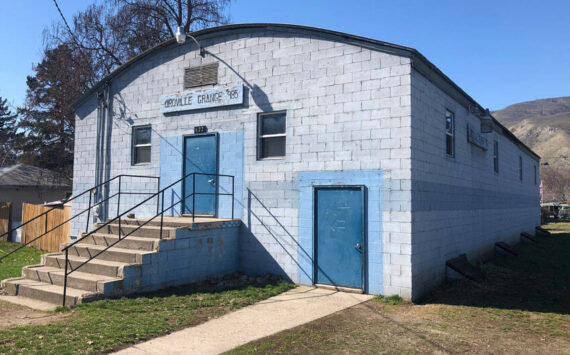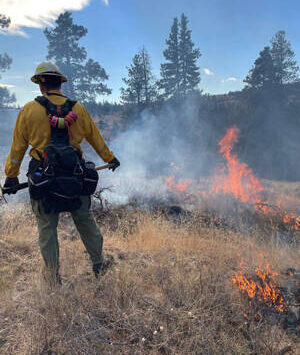OROVILLE – The Oroville Council approved Verizon Wireless’ request for a new cell phone tower located at 2019 1/2 Highland Drive despite objections by some who live nearby.
‘Can you hear me now?’ might be replaced by ‘Can you see it now’ as a 35-foot antenna, the top just visible from Highland Drive, will now be joined by one that shoots upward almost 50 feet further into the air. However, rather than a monopole design with six-foot arms stretching from it’s sides and an array of dishes dangling from it, at the insistence of the council all the antennas will be installed within the cylinder forming the tower. This will result will look like what some at the council described as a very tall flagpole.
The decision was made at the council’s Tuesday, June 16 meeting following a continuance of a closed record public hearing from the council’s previous meeting where the tower was denied based on its aesthetic impact to the neighborhood.
After reopening the hearing, Mayor Chuck Spieth called on Chris Branch, director of Community Development to discuss the council’s grounds for denying a Conditional Use Permit to allow for the tower in a residential neighborhood. He listed several plausible reasons, including the fact that Oroville has areas that are zoned to allow for such high utility towers without getting Conditional Use Permits.
“In the Industrial Zone, for example, there are no height requirements,” said Branch. “In that district you could build a 250 foot tower.”
Another reason for denying the tower could have been the fact that the tower might affect property values in the Grandview area, where there are some of the highest values in the community, according to Branch.
A representative from Verizon Wireless, who was present to clarify why the location was so important, said the site was chosen by the company’s engineers and was the optimum spot to improve cell phone coverage in the Oroville area.
“The precise location allows for maximum penetration based on line-of-site,” he said. “The engineers did not look at alternatives that did not suit our needs.”
In addition to offering the best coverage, the site also offers ready connection to power and the availability of three to five T1 telephone lines as the tower will be used for both voice and data transmission, he said.
Branch discussed various means that have been used to disguise cell towers in other communities, including making them look like trees. He said there was a tower in Chelan that looked like, and was used as, a flag pole.
“From what I understand the only thing the neighbors there don’t like about it is when the cables smack against the pole in the wind,” said Branch.
Councilman Ed Naillon asked if the antennas could be hidden internally inside the tower, leaving what would look like a large pole.
“If we can achieve our height requirements it could be done with little loss of coverage,” said the Verizon representative.
Naillon made a motion to allow an 80 foot monotower with all internal antennas, including any add-ons the company leases to other wireless providers. This would agree with the Planning Commissions original finding, with the exception that all antennas be within the tower. The motion received a second and was approved.
In other business, the council was informed that the city is fifth of seven for approval of a grant that will help the city pay for the installation of a new bio-solids treatment system at its wastewater treatment facility.
“This a grant, not a loan,” said Rod Noel, Superintendent of Public Works. “This will reflect in a utility rate decrease in what the ratepayers in town would have had to pay if we got a loan instead.”
The city thought it had the go ahead to use money from a Public Trust Fund Loan secured by the county to complete the Eastlake Sewer Project, however, the county instead used much of the remaining money to repair the road torn up by the project. This left Oroville in the position of having to seek money elsewhere at higher interest rates, which would have been passed on to the ratepayers.
Police Chief Clay Warnstaff reported that he had also secured two grants. The first was from the department of Community Trade and Economic Development for $9,999. Warnstaff said the department would be able to buy some surveillance cameras that can be remotely operated and placed in certain areas where they are specifically needed, as well as digital cameras for evidence recording. He said his department would also purchase two Tasers, two pairs of two-way radios and a Halligan tool, which he described as a “fancy crowbar for gaining entry into buildings.” In addition, some of the money will be used for wages to set aside three hours a week for a Code Enforcement Officer for a period of one year, as well as to send an officer to firearms training so he can certify the other officers in the department.
The second grant is a Stonegarden Grant from the federal Department of Homeland Security (DHS) in the amount of $13,267 and involves no out-of-pocket money on the part of the city. It will pay for training so Oroville Police Officers can go on Special Operations with the US Border Patrol on the Oroville officers’ days off.
“It will pay for one set of night vision and the rest will be for overtime wages for two operations a month helping the Border Patrol and our guys get a little extra training and coin in their pockets,” said Chief Warnstaff.
“I’m impressed, you’ve done very well,” said Mayor Spieth.
The mayor proclaimed Saturday, July 25 as Oroville Airport Days in honor of Dorothy Scott, for whom the airport is named.







